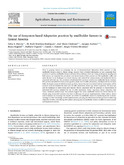| dc.contributor.author | Harvey, Celia A. | |
| dc.contributor.author | Martínez-Rodríguez, M. Ruth | |
| dc.contributor.author | Cárdenas, José Mario | |
| dc.contributor.author | Avelino, Jacques | |
| dc.contributor.author | Rapidel, Bruno | |
| dc.contributor.author | Vignola, Raffaele | |
| dc.contributor.author | Donatti, Camila I. | |
| dc.contributor.author | Vilchez-Mendoza, Sergio | |
| dc.date.accessioned | 2020-08-28T22:53:29Z | |
| dc.date.available | 2020-08-28T22:53:29Z | |
| dc.date.issued | 2017 | |
| dc.identifier.uri | http://dx.doi.org/10.1016/j.agee.2017.04.018 | |
| dc.identifier.uri | https://repositorio.catie.ac.cr/handle/11554/9541 | |
| dc.description.abstract | There is growing interest in promoting the use of Ecosystem-based Adaptation (EbA) practices to help smallholder farmers adapt to climate change, however there is limited information on how commonly these practices are used by smallholder farmers and what factors influence their use. Using participatory mapping and field surveys, we examined the prevalence and characteristics of EbA practices on 300 smallholder coffee and maize farmers in six landscapes in Central America and explored the socioeconomic and biophysical factors associated with their use. The prevalence of individual EbA practices varied across smallholder farms. Common EbA practices included live fences, home gardens, shade trees in coffee plantations, and dispersed trees in maize fields. We found a mean of 3.8 EbA practices per farm. Factors that were correlated with the total number of EbA practices on farms included the mean area of coffee plantations, farmer age, farmer experience, the farm type and the landscape in which farms were located. Factors associated with the presence or characteristics of individual EbA practices included the size of coffee plantations, farmer experience, farmer education, land tenure, landscape and farm type. Our analysis suggests that many smallholder farmers in Central America are already using certain EbA practices, but there is still scope for greater implementation. Policy makers, donors and technicians can encourage the broader use of EbA by smallholder farmers by facilitating farmer-to-farmer exchanges to share knowledge on EbA implementation, assessing the effectiveness of EbA practices in delivering adaptation benefits, and tailoring EbA policies and programs for smallholder farmers in different socioeconomic and biophysical contexts. | es_ES |
| dc.language.iso | en | es_ES |
| dc.publisher | Elsevier, Ámsterdam (Países Bajos) | es_ES |
| dc.relation.ispartof | Agriculture, Ecosystems and Environment, Volumen 246 (2017), pages 279–290 | es_ES |
| dc.rights | info:eu-repo/semantics/restrictedAccess | es_ES |
| dc.subject | ADAPTACIÓN | es_ES |
| dc.subject | ECOSISTEMA | es_ES |
| dc.subject | CAMBIO CLIMÁTICO | es_ES |
| dc.subject | PRODUCTORES DE CAFÉ | es_ES |
| dc.subject | PLANTACION | es_ES |
| dc.subject | AGRICULTORES | es_ES |
| dc.subject | AGRICULTURA | es_ES |
| dc.subject | AGROFORESTAL | es_ES |
| dc.subject | CULTIVO | es_ES |
| dc.subject | AMERICA CENTRAL | es_ES |
| dc.title | The use of Ecosystem-based Adaptation practices by smallholder farmers in Central America | es_ES |
| dc.type | Artículo | es_ES |


